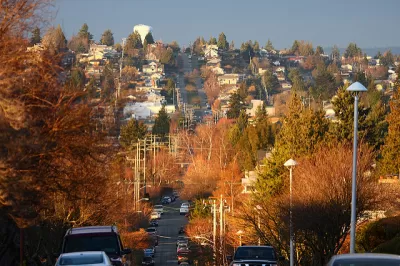"[P]erhaps at this point, this column should include a trigger warning for any young couple traumatized by the current housing market around here."

Gene Balk writes a column about the changes in the Seattle real estate market in terms of what money can buy.
This is not a happy story for many professional, middle-class residents of the city. "It’s hard to believe there was a time, and not really that long ago, when journalists — or teachers, or nurses — could go house hunting in the city of Seattle and actually buy something," writes Balk.
Even adjusting for inflation, the prices of homes in the final decades of the 20th century were far more attainable. For instance, "Census data shows that the median home value in King County in 1980 was $71,400, which, in today’s dollars, is about $225,000. That’s well below half of what it is now," reports Balk.
Balk's presentation of this information is underwritten by the implications of generational conflict. "How much less did boomers pay for their Seattle homes?" asks one of the infographics in the story (and the headline, for that matter).
To even the scales a little, Balk offers a few data points in defense of baby boomers:
…for a lot of folks back then, it didn’t seem so cheap. Keep in mind that King County home values in 1980 were about 50% higher than the U.S. median.
Another mitigating factor: Mortgage interest rates were much higher in the past, particularly in the early 1980s, when they peaked at around 16%. They didn’t fall back down into the single digits until the early 1990s.
There have always been members of the middle class cut out of the homeownership market, according to the implication of that data. Still, Balk expresses sympathy for the many among that number in 2019.
FULL STORY: How much easier was it for baby boomers to buy a home in Seattle? Let’s adjust for inflation

Alabama: Trump Terminates Settlements for Black Communities Harmed By Raw Sewage
Trump deemed the landmark civil rights agreement “illegal DEI and environmental justice policy.”

Study: Maui’s Plan to Convert Vacation Rentals to Long-Term Housing Could Cause Nearly $1 Billion Economic Loss
The plan would reduce visitor accommodation by 25% resulting in 1,900 jobs lost.

Why Should We Subsidize Public Transportation?
Many public transit agencies face financial stress due to rising costs, declining fare revenue, and declining subsidies. Transit advocates must provide a strong business case for increasing public transit funding.

Paris Bike Boom Leads to Steep Drop in Air Pollution
The French city’s air quality has improved dramatically in the past 20 years, coinciding with a growth in cycling.

Why Housing Costs More to Build in California Than in Texas
Hard costs like labor and materials combined with ‘soft’ costs such as permitting make building in the San Francisco Bay Area almost three times as costly as in Texas cities.

San Diego County Sees a Rise in Urban Coyotes
San Diego County experiences a rise in urban coyotes, as sightings become prevalent throughout its urban neighbourhoods and surrounding areas.
Urban Design for Planners 1: Software Tools
This six-course series explores essential urban design concepts using open source software and equips planners with the tools they need to participate fully in the urban design process.
Planning for Universal Design
Learn the tools for implementing Universal Design in planning regulations.
Smith Gee Studio
Alamo Area Metropolitan Planning Organization
City of Santa Clarita
Institute for Housing and Urban Development Studies (IHS)
City of Grandview
Harvard GSD Executive Education
Toledo-Lucas County Plan Commissions
Salt Lake City
NYU Wagner Graduate School of Public Service





























